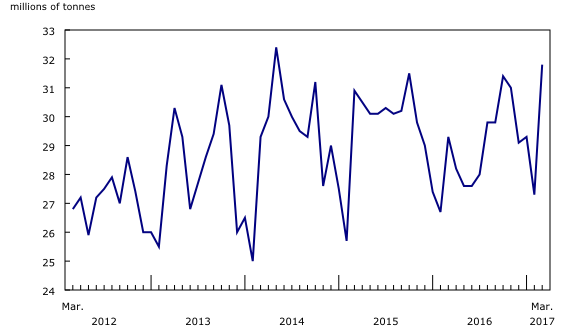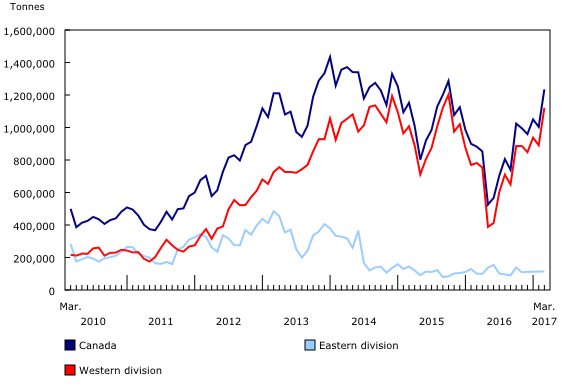Railway carloadings, March 2017
Archived Content
Information identified as archived is provided for reference, research or recordkeeping purposes. It is not subject to the Government of Canada Web Standards and has not been altered or updated since it was archived. Please "contact us" to request a format other than those available.
Released: 2017-05-31
31.8 million tonnes
March 2017
8.8% 
(12-month change)
The volume of rail freight carried in Canada totalled 31.8 million tonnes in March, up 8.8% from the same month last year.
In March, freight originating in Canada increased 7.6% from the same month last year to 28.8 million tonnes. Non-intermodal freight increased 5.5% to 312,000 carloads in March. The amount of freight loaded into these cars totalled 25.7 million tonnes, up 7.0% from the same month last year.
Tonnages of iron ores and concentrates (+16.5%), fuel oils and crude petroleum (+40.0%), fresh, chilled or dried vegetables (+140.6%) and coal (+6.7%) were up in March compared with the same month last year.
Conversely, tonnages of wheat (-13.3%), other chemical products and preparations (-42.0%), sulphur (-14.6%) and nickel ores and concentrates (-38.4%) shipped by rail declined in March on a year-over-year basis.
Intermodal freight loadings rose 12.2% from March 2016 to 197,000 units in March. The increase stemmed from a 12.2% gain in containers-on-flat-cars and a 16.2% increase in trailers-on-flat-cars. In terms of weight, intermodal traffic rose 13.4% to 3.0 million tonnes.
Freight traffic received from the United States rose 21.4% to 3.1 million tonnes as a result of a 24.3% increase in non-intermodal freight and a 6.9% decline in intermodal freight from the United States.

In celebration of the country's 150th birthday, Statistics Canada is presenting snapshots from our rich statistical history.
Oil
Historically, most of Canada's oil refining capacity has been concentrated in the East, closer to markets and ports receiving imported oil. Today, crude petroleum produced in Western Canada is shipped to markets either by pipeline or by rail.
From 1999 through mid-2011, there was relatively little in the way of fuel oils and crude petroleum shipped by rail; monthly shipments averaged nearly 390 000 tonnes or 1.9% of total (non-intermodal) tonnage moved. From mid-2011 to March 2017, monthly shipments of fuel oils and crude petroleum averaged over 975 000 tonnes. Coinciding with plateauing world prices in early 2014, oil by rail shipments peaked in January 2014—representing 6.9% of total tonnage.
Prices matter
The increase in fuel oils and crude petroleum shipped by rail coincided with higher world oil prices and a growing gap between the world market price and the Canadian market price. When the difference between these two prices widens, it is profitable for the oil refineries in Eastern Canada to buy the less expensive Canadian oil and ship it by rail from the western oil patch. With falling world oil prices in 2014, however, this gap has narrowed and the price difference cannot cover the higher cost of shipping by rail compared with pipeline or alternatively importing oil by tanker.
Note to readers
The Monthly Railway Carloadings Survey collects data, including the number of rail cars, tonnage, units and 20-feet equivalent units, from railways operating in Canada that provide for-hire freight service.
Non-intermodal freight is cargo moved via box cars or loaded in bulk. Intermodal freight is cargo moved via containers and trailers on flat cars.
Data are available for Canada, the eastern division and the western division. For statistical purposes, cargo loadings from Thunder Bay, Ontario to the Pacific Coast are classified to the western division, while loadings from Armstrong, Ontario to the Atlantic Coast are classified to the eastern division.
Data in this release are not seasonally adjusted.
Contact information
For more information, or to enquire about the concepts, methods or data quality of this release, contact us (toll-free 1-800-263-1136; 514-283-8300; STATCAN.infostats-infostats.STATCAN@canada.ca) or Media Relations (613-951-4636; STATCAN.mediahotline-ligneinfomedias.STATCAN@canada.ca).
- Date modified:



